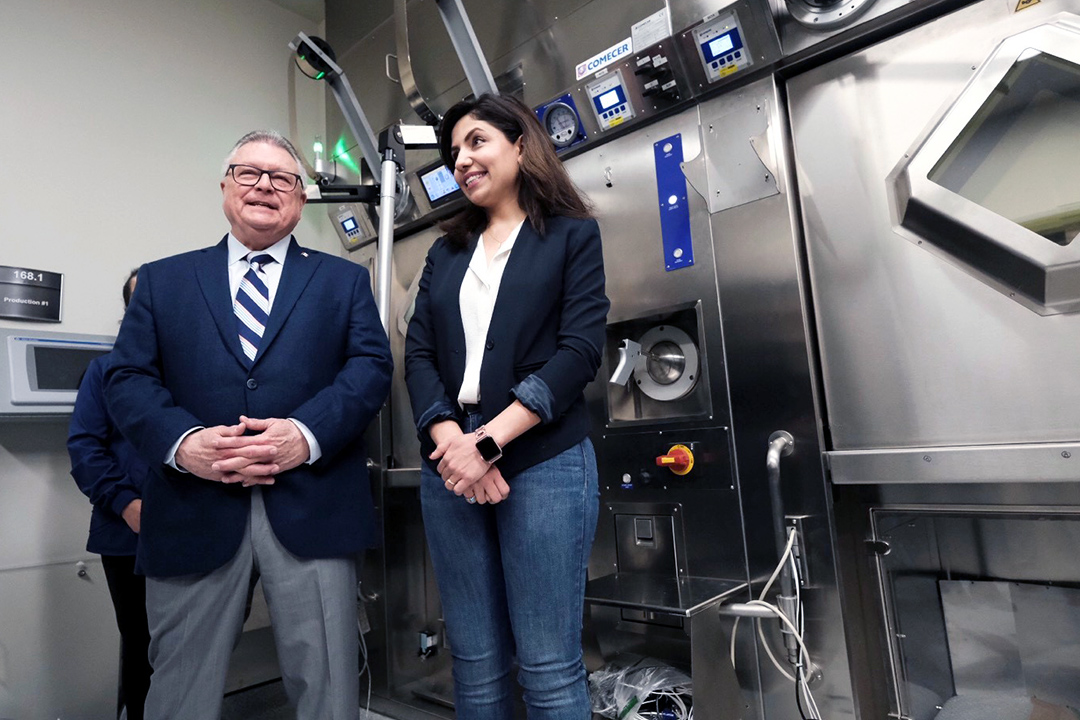
Government invests in USask nuclear innovation
With $3.6 million in new funding, the Saskatchewan Centre for Cyclotron Sciences (SCCS) at the University of Saskatchewan will renovate and equip its Innovation Wing to conduct leading-edge imaging research that will improve detection of cancers and other diseases, and advance human, animal and plant health.
At an event today at the University of Saskatchewan (USask), Canada’s Public Safety and Emergency PreparednessMinister Ralph Goodale announced an investment of $2.2 million in the project from Western Economic Diversification Canada. The Sylvia Fedoruk Centre for Nuclear Innovation (Fedoruk Centre), which operates the university’s world-class cyclotron facility, is contributing another $1.4 million.
“This major federal investment in a key component of our university’s life sciences cluster enhances our unique-in-Canada capability for innovative imaging research related to humans, animals and plants,” said Karen Chad, USask Vice-President Research.
“Our cyclotron’s new Innovation Wing will reveal underlying processes in living specimens that can lead to disease, complementing the outstanding biomedical imaging at our Canadian Light Source synchrotron and together improving health and agriculture in Canada.”
Since its establishment in 2016, SCCS has provided medical isotopes for nuclear imaging scans of more than 5,000 patients at Royal University Hospital, as well as patients in Alberta and Manitoba, to diagnose and treat cancer.
The renovated wing will be equipped to help researchers develop nuclear imaging drugs that carry nuclear isotopes to detect and treat cancer and other diseases, and to prove the effectiveness of these drugs in living specimens.
“For over 60 years, Canada and Saskatchewan have been the home to pioneers in nuclear medicine and technology. Through today’s investment, the Government of Canada is supporting the work of the next generation of nuclear innovators to create new technologies, new treatments for diseases, and to contribute to a sustainable economy,” said Goodale.
Laboratories in the Innovation Wing will enable more than 20 young researchers to test better methods of diagnosing cancer, Parkinson’s, Alzheimer’s and coronary diseases, create targeted therapies, and use nuclear imaging to better understand soil bacteria and the flow of nutrients in plants to advance sustainable agriculture.
“We are deeply grateful to Western Economic Diversification Canada for helping to equip the innovation wing, enabling Saskatchewan students and researchers to advance agriculture, veterinary medicine and human medicine,” said John Root, Fedoruk Centre executive director.
By 2021, the Innovation Wing is expected to train at least 50 highly qualified people, attract $500,000 or more of business expenditures on research and development, produce 60 or more patents or publications about nuclear imaging in life sciences, and help to advance 10 new products, services or technologies into the marketplace.
Elaheh Khozeimeh Sarbisheh, USask post-doctoral fellow in radiochemistry, said radiochemistry will play a crucial role in making new diagnostic and therapeutic radiopharmaceuticals.
“I am confident that this centre will lead to some new treatments for cancer and other diseases,” she said. “With North America’s aging population, there will be an increasing number of people with cancer and Parkinson’s disease, as well as with multi-drug-resistant bacterial infections. This facility will benefit not only Saskatchewan and the rest of Canada, but also the world at large.”
More details at: http://www.fedorukcentre.ca/facilities/cyclotron.php
–30–
For more information, contact:
Jennifer Thoma
Media Relations Specialist
University of Saskatchewan
jennifer.thoma@usask.ca
306-966-1851
Article re-posted on .
View original article.

